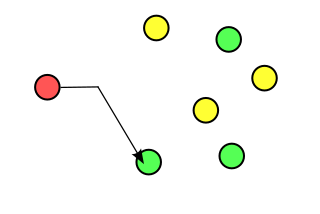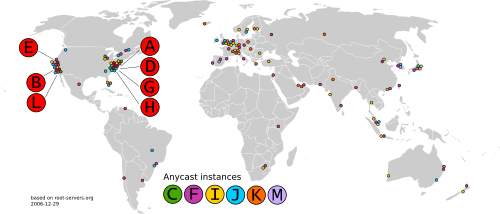The Domain Name System (DNS) is a hierarchical and distributed name service that provides a naming system for computers, services, and other resources in the Internet or other Internet Protocol (IP) networks. It associates various information with domain names assigned to each of the associated entities. Most prominently, it translates readily memorized domain names to the numerical IP addresses needed for locating and identifying computer services and devices with the underlying network protocols. The Domain Name System has been an essential component of the functionality of the Internet since 1985.

The Internet Corporation for Assigned Names and Numbers is a global multistakeholder group and nonprofit organization headquartered in the United States responsible for coordinating the maintenance and procedures of several databases related to the namespaces and numerical spaces of the Internet, ensuring the Internet's stable and secure operation. ICANN performs the actual technical maintenance work of the Central Internet Address pools and DNS root zone registries pursuant to the Internet Assigned Numbers Authority (IANA) function contract. The contract regarding the IANA stewardship functions between ICANN and the National Telecommunications and Information Administration (NTIA) of the United States Department of Commerce ended on October 1, 2016, formally transitioning the functions to the global multistakeholder community.
A top-level domain (TLD) is one of the domains at the highest level in the hierarchical Domain Name System of the Internet after the root domain. The top-level domain names are installed in the root zone of the name space. For all domains in lower levels, it is the last part of the domain name, that is, the last non-empty label of a fully qualified domain name. For example, in the domain name www.example.com, the top-level domain is .com. Responsibility for management of most top-level domains is delegated to specific organizations by the ICANN, an Internet multi-stakeholder community, which operates the Internet Assigned Numbers Authority (IANA), and is in charge of maintaining the DNS root zone.
A name server is a computer application that implements a network service for providing responses to queries against a directory service. It translates an often humanly meaningful, text-based identifier to a system-internal, often numeric identification or addressing component. This service is performed by the server in response to a service protocol request.

In the Internet, a domain name is a string that identifies a realm of administrative autonomy, authority or control. Domain names are often used to identify services provided through the Internet, such as websites, email services and more. Domain names are used in various networking contexts and for application-specific naming and addressing purposes. In general, a domain name identifies a network domain or an Internet Protocol (IP) resource, such as a personal computer used to access the Internet, or a server computer.

The Internet Assigned Numbers Authority (IANA) is a standards organization that oversees global IP address allocation, autonomous system number allocation, root zone management in the Domain Name System (DNS), media types, and other Internet Protocol–related symbols and Internet numbers.
A domain name registry is a database of all domain names and the associated registrant information in the top level domains of the Domain Name System (DNS) of the Internet that enables third party entities to request administrative control of a domain name. Most registries operate on the top-level and second-level of the DNS.
The DNS root zone is the top-level DNS zone in the hierarchical namespace of the Domain Name System (DNS) of the Internet.
The Domain Name System Security Extensions (DNSSEC) are a suite of extension specifications by the Internet Engineering Task Force (IETF) for securing data exchanged in the Domain Name System (DNS) in Internet Protocol (IP) networks. The protocol provides cryptographic authentication of data, authenticated denial of existence, and data integrity, but not availability or confidentiality.
The Internet uses the Domain Name System (DNS) to associate numeric computer IP addresses with human-readable names. The top level of the domain name hierarchy, the DNS root, contains the top-level domains that appear as the suffixes of all Internet domain names. The most widely used DNS root is administered by the Internet Corporation for Assigned Names and Numbers (ICANN). In addition, several organizations operate alternative DNS roots, often referred to as alt roots. These alternative domain name systems operate their own root name servers and commonly administer their own specific name spaces consisting of custom top-level domains.

Anycast is a network addressing and routing methodology in which a single IP address is shared by devices in multiple locations. Routers direct packets addressed to this destination to the location nearest the sender, using their normal decision-making algorithms, typically the lowest number of BGP network hops. Anycast routing is widely used by content delivery networks such as web and name servers, to bring their content closer to end users.
The domain name arpa is a top-level domain (TLD) in the Domain Name System (DNS) of the Internet. It is used predominantly for the management of technical network infrastructure. Prominent among such functions are the subdomains in-addr.arpa and ip6.arpa, which provide namespaces for reverse DNS lookup of IPv4 and IPv6 addresses, respectively.

The domain names example.com, example.net, example.org, and example.edu are second-level domain names in the Domain Name System of the Internet. They are reserved by the Internet Assigned Numbers Authority (IANA) at the direction of the Internet Engineering Task Force (IETF) as special-use domain names for documentation purposes. The domain names are used widely in books, tutorials, sample network configurations, and generally as examples for the use of domain names. The Internet Corporation for Assigned Names and Numbers (ICANN) operates web sites for these domains with content that reflects their purpose.

A DNS zone is a specific portion of the DNS namespace in the Domain Name System (DNS), which a specific organization or administrator manages. A DNS zone is an administrative space allowing more granular control of the DNS components, such as authoritative nameserver. The DNS is broken up into different zones, distinctly managed areas in the DNS namespace. DNS zones are not necessarily physically separated from one another; however, a DNS zone can contain multiple subdomains, and multiple zones can exist on the same server.
Distributed denial-of-service attacks on root nameservers are Internet events in which distributed denial-of-service attacks target one or more of the thirteen Domain Name System root nameserver clusters. The root nameservers are critical infrastructure components of the Internet, mapping domain names to IP addresses and other resource record (RR) data.

Open Root Server Network (ORSN) was a network of Domain Name System root nameservers for the Internet. ORSN DNS root zone information was kept in synchronization with the "official" Domain Name System root nameservers coordinated by ICANN. The networks were 100% compatible, though ORSN was operated independently. The ORSN servers were primarily placed in Europe. ORSN is also used by public name servers, providing Domain Name System access freely for everyone, without any limitation until the project closed in May 2019. ORSN was primarily started to reduce the over-dependence of Internet users on the United States and Department of Commerce/IANA/ICANN/VeriSign, limit the control over the Internet that this gives, while ensuring that domain names remain unambiguous. It also helps avoid the technical possibility of global "Internet shutdown" by one party. They also expect their network to make domain name resolutions faster for everyone.
RIPE NCC is the regional Internet registry (RIR) for Europe, the Middle East and parts of Central Asia. Its headquarters are in Amsterdam, Netherlands, with a branch office in Dubai, UAE.
WHOIS is a query and response protocol that is used for querying databases that store an Internet resource's registered users or assignees. These resources include domain names, IP address blocks and autonomous systems, but it is also used for a wider range of other information. The protocol stores and delivers database content in a human-readable format. The current iteration of the WHOIS protocol was drafted by the Internet Society, and is documented in RFC 3912.
Blackhole DNS servers are Domain Name System (DNS) servers that return a "nonexistent address" answer to reverse DNS lookups for addresses reserved for private use.

An Internet Protocol version 6 address is a numeric label that is used to identify and locate a network interface of a computer or a network node participating in a computer network using IPv6. IP addresses are included in the packet header to indicate the source and the destination of each packet. The IP address of the destination is used to make decisions about routing IP packets to other networks.









